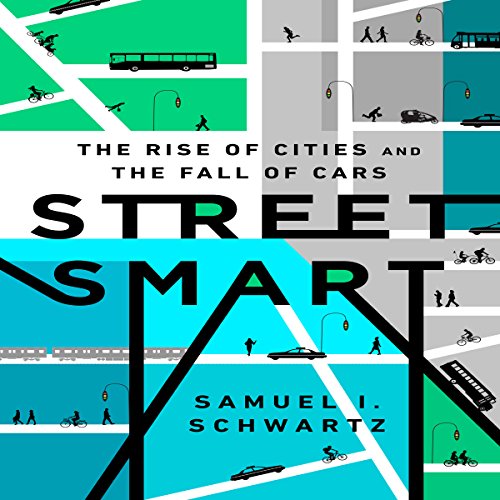
 Audible sample
Audible sample  Playing...
Playing... 
 Paused
Paused  Your audiobook is waiting!
Your audiobook is waiting!
Enjoy a free trial on us
$0.00$0.00
- Click above for unlimited listening to select audiobooks, Audible Originals, and podcasts.
- One credit a month to pick any title from our entire premium selection — yours to keep (you'll use your first credit now).
- You will get an email reminder before your trial ends.
- $14.95$14.95 a month after 30 days. Cancel online anytime.
Buy
-12% $23.39$23.39
The Death and Life of Great American Cities: 50th Anniversary Edition
 Audible Audiobook
– Unabridged
Audible Audiobook
– Unabridged
Thirty years after its publication, The Death and Life of Great American Cities was described by The New York Times as "perhaps the most influential single work in the history of town planning....[It] can also be seen in a much larger context. It is first of all a work of literature; the descriptions of street life as a kind of ballet and the bitingly satiric account of traditional planning theory can still be read for pleasure even by those who long ago absorbed and appropriated the book's arguments."
Jane Jacobs, an editor and writer on architecture in New York City in the early 60s, argued that urban diversity and vitality were being destroyed by powerful architects and city planners. Rigorous, sane, and delightfully epigrammatic, Jacobs's small masterpiece is a blueprint for the humanistic management of cities. It is sensible, knowledgeable, readable, indispensable.
The author has written a new foreword for this Modern Library edition.
- Listening Length18 hours
- Audible release dateSeptember 13, 2011
- LanguageEnglish
- ASINB005MM7JKA
- VersionUnabridged
- Program TypeAudiobook
People who viewed this also viewed
- Audible Audiobook
- Audible Audiobook
- Audible Audiobook
- Audible Audiobook
- Audible Audiobook
People who bought this also bought
- Triumph of the City: How Our Greatest Invention Makes Us Richer, Smarter, Greener, Healthier, and Happier
 Audible Audiobook
Audible Audiobook - Audible Audiobook
- Audible Audiobook
- Audible Audiobook
- How Real Estate Developers Think: Design, Profits, and Community: The City in the Twenty-First Century
 Audible Audiobook
Audible Audiobook
Related to this topic
- Audible Audiobook
- Audible Audiobook
- Audible Audiobook
- Audible Audiobook
- Audible Audiobook
Product details
| Listening Length | 18 hours |
|---|---|
| Author | Jane Jacobs, Jason Epstein - introduction |
| Narrator | Donna Rawlins |
| Audible.com Release Date | September 13, 2011 |
| Publisher | Random House Audio |
| Program Type | Audiobook |
| Version | Unabridged |
| Language | English |
| ASIN | B005MM7JKA |
| Best Sellers Rank | #11,924 in Audible Books & Originals (See Top 100 in Audible Books & Originals) #4 in Architecture (Audible Books & Originals) #7 in Urban & Land Use Planning (Books) #17 in Human Geography (Books) |
Customer reviews
Customer Reviews, including Product Star Ratings help customers to learn more about the product and decide whether it is the right product for them.
To calculate the overall star rating and percentage breakdown by star, we don’t use a simple average. Instead, our system considers things like how recent a review is and if the reviewer bought the item on Amazon. It also analyzed reviews to verify trustworthiness.
Learn more how customers reviews work on AmazonReviews with images
-
Top reviews
Top reviews from the United States
There was a problem filtering reviews right now. Please try again later.
This topic could be really tedious to read - but it's not! Within the first few pages I could tell I was in the hands of someone skilled and capable, a master at the nature of spaces and nimble with words and ideas. Jacobs was not a planner, nor an academic but a person who had been thinking and writing about architecture and cities for a long time with intelligence and with an equal gift in communicating. Her style is evocative and able to tease out subtle ideas in amusing, succinct and yet on-the-mark ways. She just nails it each time.
Published in 1961 but for the most part, reads current. Her words, her thinking and writing are all contemporary, as even the older issues she discusses are now being deconstructed and it is interesting to read the origins of many of these ideas which seem like such obvious blunders you just scratch your head at the powers-that-were who conceived them. As she puts it, "expressways that eviscerate great cities...These amputated areas typically develop galloping gangrene" and the "Low-income projects that become worse centers of delinquency, vandalism and general social hopelessness than the slums they were supposed to replace. Middle-income housing projects which are truly marvels of dullness and regimentation, sealed against any buoyancy or vitality of city life. Luxury housing projects that mitigate their inanity, or try to, with a vapid vulgarity. Cultural centers that are unable to support a good bookstore."
"Monopolistic shopping centers and monumental cultural centers cloak, under the public relations hoohaw, the subtraction of commerce, and of culture too." Or one of my pet peeves, "Promenades that go from no place to nowhere and have no promenaders" - these seem prevalent around civic centers and drive me crazy as I walk for my transportation, the long expanses of concrete and lawn with a few concrete benches. In Paris they would put a little outdoor cafe and some trees in the middle so that one can cross that desert with an espresso pit-stop but too often there is nothing, and one starts across the huge block already fatigued wondering how it is possible that even the green of the lawn looks unappealing, that nature is devoid of its charm in these circumstances. That's not to say that Europe avoided these problems, they built tons of social housing or offices. I see examples of them every day where I live, in the middle of a vibrant city suddenly one comes upon a 1970s "super-block" with a few high rises planted in the middle of a vast patchwork of concrete and never-used lawn and bits of graffiti on lonely concrete benches. Walking these super-blocks feels like being plunged into jello, heavy, plodding and onerous. But now I understand there was thoughtful thinking behind these but like lots of theories, things just didn't work out as they hoped or were anemic budgeted and bureaucratized versions of the original vision.
Thankfully, most cities are striving to be more livable now, it's too bad that a new problem has emerged, that they are losing diversity as they become unaffordable. She also goes into the suburbs, which along with small towns, now often seem to be the new repositories of those with no choice. Enough rant. She actually spends a lot of time talking about what is good, what works and why and that too is illuminating. You know you love these things about certain neighborhoods but you don't quite know all the reasons why, why exactly it feels more vibrant, alive, organic and a place where life can bloom.
This is eminently relevant and readable. Another review complained about her use of language made it hard to follow. She is really descriptive, perhaps that could get tedious if read straight through, it's a good book to have at the bedside to read in chunks.
“The Death and Life of Great American Cities” did for urban planning, similar to what Thomas Sowell’s “Knowledge and Decisions” did for economics. Jane Jacobs sets the record straight and shows what does and does not work, for creating a successful city. She is firmly based in reality and scorns those intellectuals - Utopians as she calls them - who view cities and the people in them as some abstract entity. These individuals actually end up destroying cities and continually double down on what doesn’t work. Jacobs’ writing is almost poetic in the way she describes with such great detail the social and economic complexity that the big urban city is. She has an incredibly keen eye for observation, and those reading this book that also have an eye for the city will very much appreciate this about Jacobs.
This book is very informative and insightful. It has become one of my personal favorites within the social sciences. I think any intelligent person can read this book without needing too much prerequisite knowledge, although it might be helpful to have a fundamental understanding of economics. The core of this book lies within the first two parts: Part 1 The Peculiar Nature of Cities, and most important part of the book, Part 2 The Conditions for City Diversity. Parts 3 and 4 of the book build off of the fundamentals from the first two parts of the book. While most of the examples of certain conditions and situations in the different streets and districts of the cities (NY, LA, SF, Chicago, Boston, Philly, Baltimore; and the rust belt cities Detroit, Pittsburgh, Cleveland, Cincinnati, St. Louis, Louisville, Buffalo) that she discusses have changed - given that it’s been over half a century since she finished writing this book - all the principles still remain the same. I can attest to this because many, if not all, of the tactics and strategies that Jacobs mentions have been applied to Los Angeles in recent decades and have dramatically changed the city for the better. The book ends with an outstanding final chapter “The kind of problem a city is”. This is required reading for anyone interested in city planning or anyone fascinated by cities and wanting to learn more about how they function.






























